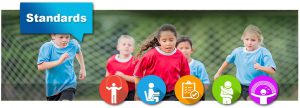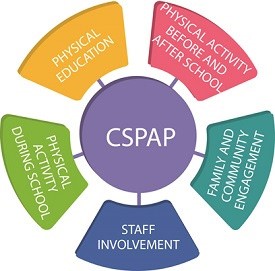By Dr. Fran Cleland, SHAPE America Past President
Physical literacy has been defined as the ability to move with competence and confidence in a wide variety of physical activities in multiple environments that benefit the healthy development of the whole person.
Developing physical literacy is a shared responsibility between schools, family, and the community. Physical education is an essential part of the process because it is where children gain knowledge about healthy behaviors — and develop the motor skills needed for physical activity.

States and local school districts across the country use SHAPE America’s National Standards and Grade-Level Outcomes for K-12 Physical Education as the foundation for achieving physical literacy within preK-12 instructional programs. The five standards include:
Standard 1: The physically literate individual demonstrates competency in a variety of motor skills and movement patterns.
Standard 2: The physically literate individual applies knowledge of concepts, principles, strategies and tactics related to movement and performance.
Standard 3: The physically literate individual demonstrates the knowledge and skills to achieve and maintain a health-enhancing level of physical activity and fitness.
Standard 4: The physically literate individual exhibits responsible personal and social behavior that respects self and others.
Standard 5: The physically literate individual recognizes the value of physical activity for health, enjoyment, challenge, self-expression and/or social interaction.
Appropriate Instruction
A well-designed, standards-based physical education curriculum should include developmentally appropriate and inclusive instructional practices. Physical educators can find numerous resources to guide them in providing those instructional experiences and fostering physical literacy, including elementary, middle and high school lesson-planning books that include hundreds of sample lessons.
Miami-Dade County Public Schools, the fourth-largest school district in the United States, has embraced physical literacy. In addition to providing standards-based instruction, the district emphasizes that content must be meaningful to students. Assessments provide immediate feedback, so students can continue to improve as they move through the curriculum and participate in sports or other physically active hobbies.
Comprehensive School Physical Activity Program
When physical literacy is supplemented by a comprehensive school physical activity program (CSPAP), the goal of helping all students become physical literate is more likely.
A CSPAP is a multi-component approach by which school districts and schools use all opportunities for students to be physically active.
The goals of a CSPAP are:
- To provide a variety of school-based physical activities to enable all students to participate in 60 minutes of moderate-to-vigorous physical activity each day (the youth recommendations from the Physical Activity Guidelines for Americans).
- To provide coordination among the CSPAP components to maximize understanding, application, and practice of the knowledge and skills learned in physical education.
SHAPE America maintains that a standards-based physical education program is a critical component of a CSPAP. Among the other components, family and community engagement is also of paramount importance. When families are active, they spend additional time together and experience health benefits. Parents, guardians, or other family members can support a CSPAP by participating in evening or weekend special events, or by serving as physical education or physical activity volunteers.
Our goal is to inspire and empower children to be physically active on their own time — and helping young people achieve physical literacy is vital to their ability and desire to lead physically active and healthy lives. Support physical literacy within your schools. Read more about physical literacy.
Spread the Word! Share this post with your networks using this sample tweet:
.@SHAPE_America Past-President @ClelandFran explains what physical literacy is and why it’s so important. https://bit.ly/2LLeNPZ